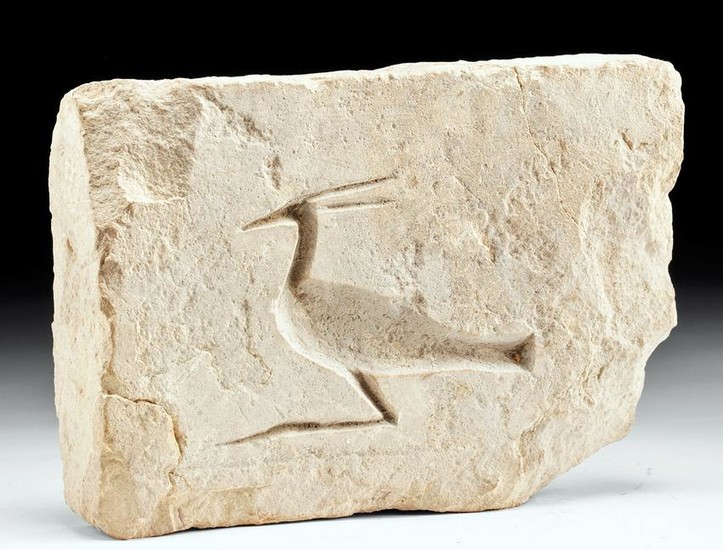Egyptian Ptolemaic Limestone Relief Plaque of Heron
Egypt, Ptolemaic Period, ca. 305 to 30 BCE. Carved from a single piece of limestone, this impressive plaque depicts a crested bird, likely a heron or egret, carved in negative relief. Herons have resided in the Nile Delta as well as along the Red Sea year round. These magnificent birds, with their fanciful crests, were clearly beloved by the ancient Egyptians, as images of the birds were quite prevalent. See a drawing of an egret on a funerary papyrus found by the Metropolitan Museum of Art's excavators in Thebes in 1929 (object number 30.3.32). According to Met scholar Dorothea Arnold, "The ancient Egyptians believed that their king ascended to heaven in the form of the crested bird, and artists also often depicted the legendary phoenix as a heron. In every- day life these avian experts in fishing were used by fowlers as decoys to lure other birds into the nets." ("An Egyptian Bestiary" - Metropolitan Museum of Art Bulletin Spring 1995, p. 31) Size: 1.75" L x 7.25" W x 5.25" H (4.4 cm x 18.4 cm x 13.3 cm)
Please note that an old collection label attached to the underside of this piece reads in part, "Limestone relief plaque depicting an Ibis, the bird that the Egyptians associated with the god Thoth who was the scribe of the gods and the moon deity, patron of writing, mathematics, and language …" However, the bird rendered on this plaque differs in appearance from an ibis in that the beak is not hooked and the bird possesses an ornamental crest akin to a heron or egret.
Provenance: private J.H. collection, Beaverton, Oregon, USA, acquired in the 1990s; ex-Tom Cederlind collection, Portland, Oregon, USA
All items legal to buy/sell under U.S. Statute covering cultural patrimony Code 2600, CHAPTER 14, and are guaranteed to be as described or your money back.
A Certificate of Authenticity will accompany all winning bids.
We ship worldwide to most countries and handle all shipping in-house for your convenience.
#150048
Condition Report: A section from a larger relief. Repaired from 3 to 6 large pieces, but very well done. Surface covered with mineral deposits. Minor nicks to peripheries of the back and chest of the egret relief.
View it on
Estimate
Time, Location
Auction House
Egypt, Ptolemaic Period, ca. 305 to 30 BCE. Carved from a single piece of limestone, this impressive plaque depicts a crested bird, likely a heron or egret, carved in negative relief. Herons have resided in the Nile Delta as well as along the Red Sea year round. These magnificent birds, with their fanciful crests, were clearly beloved by the ancient Egyptians, as images of the birds were quite prevalent. See a drawing of an egret on a funerary papyrus found by the Metropolitan Museum of Art's excavators in Thebes in 1929 (object number 30.3.32). According to Met scholar Dorothea Arnold, "The ancient Egyptians believed that their king ascended to heaven in the form of the crested bird, and artists also often depicted the legendary phoenix as a heron. In every- day life these avian experts in fishing were used by fowlers as decoys to lure other birds into the nets." ("An Egyptian Bestiary" - Metropolitan Museum of Art Bulletin Spring 1995, p. 31) Size: 1.75" L x 7.25" W x 5.25" H (4.4 cm x 18.4 cm x 13.3 cm)
Please note that an old collection label attached to the underside of this piece reads in part, "Limestone relief plaque depicting an Ibis, the bird that the Egyptians associated with the god Thoth who was the scribe of the gods and the moon deity, patron of writing, mathematics, and language …" However, the bird rendered on this plaque differs in appearance from an ibis in that the beak is not hooked and the bird possesses an ornamental crest akin to a heron or egret.
Provenance: private J.H. collection, Beaverton, Oregon, USA, acquired in the 1990s; ex-Tom Cederlind collection, Portland, Oregon, USA
All items legal to buy/sell under U.S. Statute covering cultural patrimony Code 2600, CHAPTER 14, and are guaranteed to be as described or your money back.
A Certificate of Authenticity will accompany all winning bids.
We ship worldwide to most countries and handle all shipping in-house for your convenience.
#150048
Condition Report: A section from a larger relief. Repaired from 3 to 6 large pieces, but very well done. Surface covered with mineral deposits. Minor nicks to peripheries of the back and chest of the egret relief.



